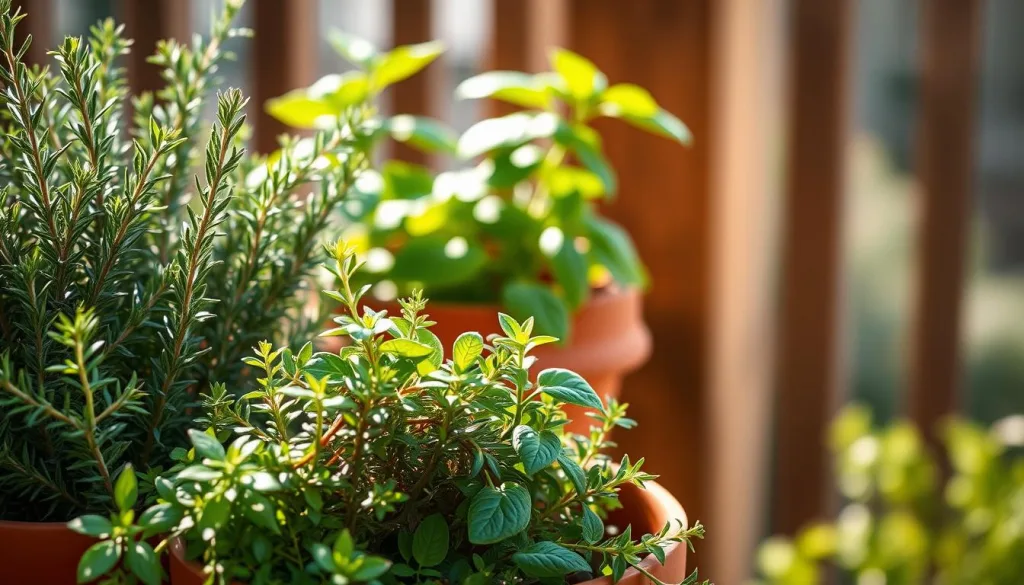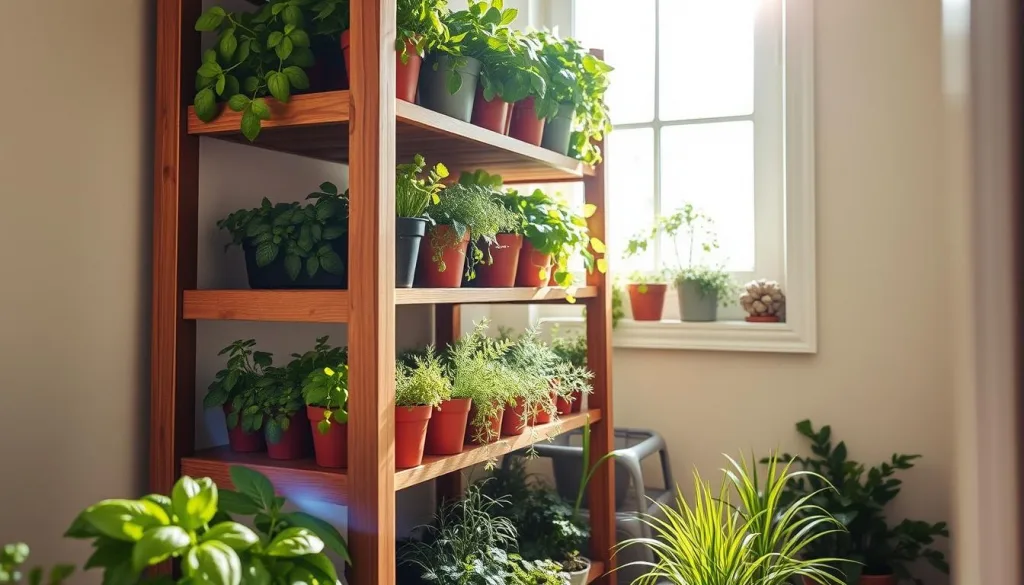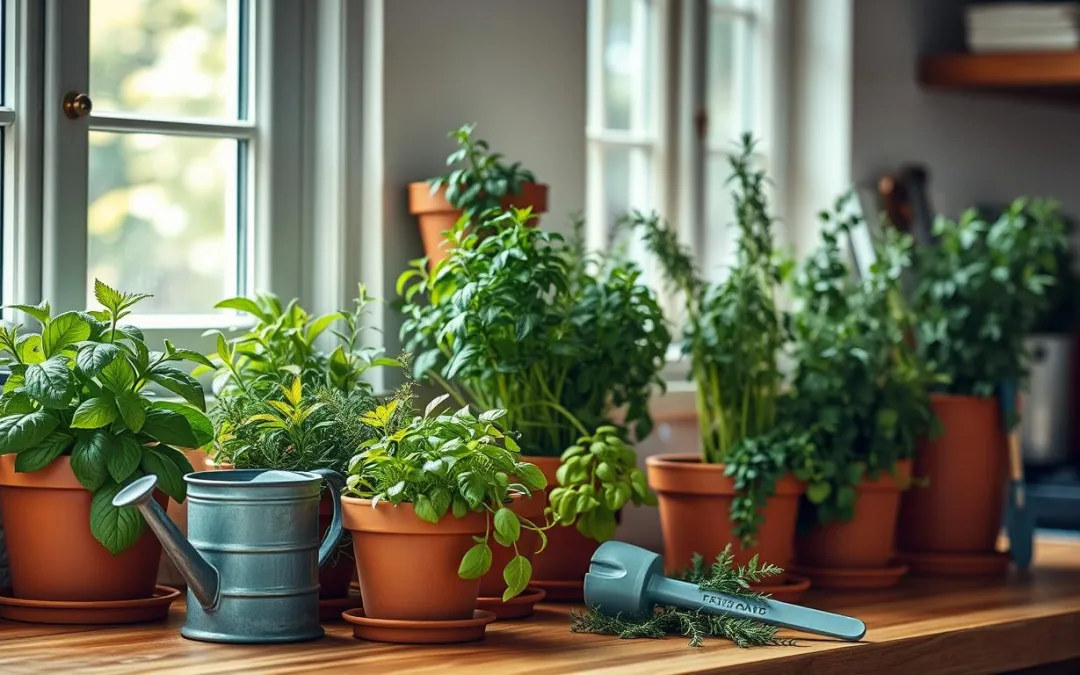Starting an herb garden opens up new worlds in cooking and health. With over 25 years of gardening, I’ve found growing herbs at home is easy and rewarding. It’s great for both new and experienced gardeners.
Herb gardening lets you change your cooking, improve your health, and connect with nature. You don’t need a big backyard to start. Even a small balcony can work. Herbs are tough and easy for beginners to grow.
There are many herbs to try, like oregano, basil, rosemary, and thyme. Seeds are cheap, and most herbs do well indoors or outdoors with little care. Your herb garden gives you fresh, organic ingredients for better meals and health.
Key Takeaways
- Herbs are easier to grow compared to most vegetables
- Indoor and outdoor herb gardens are possible for any living space
- Herbs provide fresh, organic ingredients year-round
- Minimal investment required to start herb gardening
- Growing herbs reduces carbon footprint
Understanding the Benefits of Home Herb Gardens
Growing fresh herbs at home is more than a hobby. It’s a way to change how we cook, stay healthy, and care for the planet. An indoor herb garden brings many benefits that go beyond just making food taste better.
Cost-Effective Culinary Enhancement
Having your own herb garden can cut down on grocery bills. Studies show that home herb gardens can save families $100 to $200 a year. One packet of seeds can give you months of fresh herbs, just like buying a single bunch.
- Fresh herbs can make dishes taste 30% better
- Homegrown herbs are 20 times fresher than store-bought
- Seeds give you more harvests than buying from stores
Natural Health and Wellness Benefits
An indoor herb garden is great for your health. It gives you nutritious ingredients and helps you relax. Studies show that gardening can reduce stress, lower anxiety, and boost mental health.
Environmental Impact and Sustainability
Growing herbs at home is good for the planet. Home gardens can cut carbon footprints by up to 25% compared to buying from stores. The National Gardening Association says 75% of new gardeners want to grow their own food, showing a big move towards being green.
Cultivating an indoor herb garden is more than a hobby – it’s a holistic approach to health, flavor, and environmental responsibility.
Essential Tools and Materials for Growing Herbs at Home
Starting your indoor herb garden needs careful planning and the right tools. Good herb care begins with choosing the best tools and materials for your plants.
Here are the key items for a successful indoor herb garden:
- Containers with drainage holes – Important for preventing root rot and healthy growth
- High-quality potting mix made for herbs
- Pruning shears for keeping plants healthy
- Watering can with a fine spray nozzle
- Plant markers for tracking different herbs
- Grow lights for steady indoor light
Soil quality is key for your indoor herb garden. I suggest a mix rich in nutrients for growth. Use topsoil, compost, and sand for the best soil. This mix gives your plants the nutrients they need and helps with drainage.
Pro tip: Indoor herb gardens need about 8 hours of bright light for best growth.
Temperature is also important for herb care. Most herbs do well in temperatures between 60°F and 85°F. A heating mat can help seeds germinate faster and improve plant success.
If you love growing herbs indoors, investing in quality tools is a must. The success of your herb garden depends on the right materials and careful planning.
Selecting the Perfect Location for Your Herb Garden
Starting a successful herb garden begins with picking the right spot. Whether you’re starting fresh or growing your garden, the location is key. It affects your plants’ health and how well they grow.
When growing herbs, several important factors come into play. Knowing these will help you create the best space for your herbs.
Indoor vs. Outdoor Considerations
Choosing where to put your herb garden depends on a few things:
- Available sunlight
- Temperature stability
- Humidity levels
- Accessibility for maintenance
Light Requirements and Exposure
Most herbs need lots of sunlight. They do best with six to eight hours of direct sunlight every day. Without enough light, herbs can become weak and not produce well.
| Herb Type | Sunlight Requirement | Best Location |
|---|---|---|
| Basil | Full Sun | South-facing Window |
| Mint | Partial Shade | East-facing Window |
| Rosemary | Full Sun | Sunny Outdoor Spot |
Temperature and Humidity Factors
Herbs usually do well in temperatures between 60-70°F (15-21°C). Indoor spaces can be hard because they often have low humidity. This makes plants more likely to get pests.
“The secret to a thriving herb garden is understanding and mimicking your plants’ natural habitat.” – Gardening Expert
Tip for beginners: Begin with a small indoor setup or a few pots on a sunny windowsill. This lets you control the environment better and helps you get better at growing herbs.
Creating the Ideal Soil Mix for Herbs
Growing herbs at home starts with the right soil mix. The perfect soil mix is key to a healthy and productive herb garden.
For outdoor herb gardening, I suggest a balanced mix. It should include:
- 1 part compost
- 1 part coconut coir
- 1 part perlite or rice hulls
Indoor herb gardening needs a different mix. It should be light and hold moisture well. Here’s a good mix:
- 2 parts sterilized compost
- 1 part worm castings
- 1 part perlite
- 1 part vermiculite
- 1 part sand
When making your soil mix, watch the pH level. Most herbs like slightly acidic to neutral soil. Aim for a pH between 6-7. Testing your soil can help adjust it for your herbs.
Don’t over-fertilize your herbs. Too much fertilizer can harm their flavor and essential oils. Instead, use a balanced mix that matches their natural environment.
Remember, good soil is the cornerstone of a thriving herb garden, whether you’re growing indoors or outdoors.
Top Easy-to-Grow Herbs for Beginners
Starting an indoor herb garden is rewarding for both gardening fans and food lovers. It’s a great way to add fresh, organic flavors to your cooking. Plus, it’s good for the planet.
Some herbs are perfect for beginners. They grow well, need little care, and taste amazing. These herbs can make your cooking better.
Basil and Mint: Perfect Starter Herbs
Basil and mint are great for new gardeners. They grow well in many conditions and fill your indoor garden fast.
- Basil grows 1-2 feet tall and needs full sun
- Mint can reach 1-3 feet and does well in containers
- Both herbs like moist, well-draining soil
Rosemary and Thyme: Hardy Mediterranean Herbs
Mediterranean herbs like rosemary and thyme are tough and easy to care for. They handle different environments and need little attention.
| Herb | Height | Sunlight Needs | Watering Requirements |
|---|---|---|---|
| Rosemary | 1-2 feet | Full sun | Moderate, well-drained soil |
| Thyme | 1 foot | Direct sunlight | Allow topsoil to dry between waterings |
Sage and Oregano: Robust Culinary Herbs
Sage and oregano are good for cooking and health. They’re great for those who don’t have much time to care for plants.
- Sage grows 1-3 feet tall
- Oregano reaches 1-2 feet
- Both herbs prefer sunny, dry spots
To succeed with indoor herbs, know what each needs. Regularly picking your herbs helps them grow bushier. This way, you always have fresh, tasty herbs.
Container Gardening Techniques for Herbs

Growing herbs in pots is great for those with little space. It works well for small balconies or tiny kitchens. Knowing what each herb needs is key to success.
When picking containers, keep these points in mind:
- Choose pots with adequate drainage holes
- Select containers at least 6-8 inches deep
- Use lightweight, well-draining potting mix
- Match pot size to the herb’s mature growth
Some herbs need special setups. Mediterranean herbs like rosemary and sage love full sun. They need at least 4 hours of direct sunlight a day. For those with little space, vertical gardening is a good option.
Herb care is important in container gardens. Group herbs by their water and light needs. Learn more about sustainable herb gardening for a thriving garden.
Here are some good groupings for container gardening:
- Sun-loving herbs: basil, rosemary, oregano
- Shade-tolerant herbs: mint, parsley, chives
- Moisture-loving herbs: basil, cilantro, chervil
By knowing each herb’s needs, you can make a beautiful and productive garden. It will give you fresh herbs for cooking and wellness.
Essential Care and Maintenance Tips
Growing herbs indoors or outdoors needs careful attention and specific care. Understanding each plant’s needs and providing the best growing conditions is key.
To keep your herb garden thriving, focus on several important aspects. These will help your plants grow well and give you plenty of fresh herbs.
Watering Schedule and Methods
Watering herbs right is essential for their health. Most herbs like soil that’s a bit dry between waterings. Experts suggest checking soil moisture and using the right watering methods:
- Water when the top inch of soil feels dry
- Use a fine-rose watering can to prevent leaf damage
- Ensure root zone is moistened at least 6 inches deep
- Consider drip irrigation systems for consistent moisture
Pruning and Harvesting Techniques
Pruning regularly helps herbs grow strong and prevents them from getting too long. Strategic trimming can make your herb garden lush and productive.
- Pinch 2-3 inches off stem tips to promote branching
- Cut stems just above leaf intersections
- Harvest up to 25% of the plant without causing stress
- Stop pruning woody herbs eight weeks before first frost
Pest Control and Disease Prevention
“Prevention is better than cure” applies perfectly to herb gardening.
When growing herbs indoors or outdoors, watch out for pests and diseases. Natural ways to prevent problems include:
- Practice companion planting
- Inspect plants regularly for signs of infestation
- Use organic solutions like neem oil
- Maintain proper air circulation
- Remove diseased plant parts immediately
By following these herb care tips, you’ll have a vibrant, healthy herb garden. It will give you fresh ingredients all year round.
Growing Herbs in Small Spaces

An indoor herb garden can turn even the smallest living spaces into a lush oasis. It’s a fun and doable goal for city folks and plant lovers.
You don’t have to let small spaces stop you from growing herbs. Even a one-bedroom apartment can hold nearly 100 edible plants with the right methods. The trick is picking the right herbs and using smart gardening tricks.
- Choose compact herbs like chives, basil, and mint
- Utilize vertical gardening solutions
- Invest in multi-level planters
- Maximize window sill and countertop spaces
Vertical gardening is a game-changer for small spaces. Wall frames, hanging planters, and tiered shelves can greatly expand your growing area. The Greenstalk planter, with over 30 pockets, shows how clever design can make the most of tight spots.
When setting up an indoor herb garden, keep these points in mind:
- Ensure 6-8 hours of sunlight or use grow lights
- Select containers at least 6 inches deep
- Use well-draining, nutrient-rich soil
- Maintain consistent watering schedules
Some herbs do great in tight spots. Basil, cilantro, and scallions love small spaces. Perennial herbs like rosemary need a bit more room. Self-watering grow kits with grow lights make growing herbs easier.
Seasonal Considerations for Herb Gardens
Growing herbs at home means knowing how seasons affect plants. Herb gardening changes with the seasons. Each season has its own challenges and chances to grow healthy herbs.
To grow herbs well, you need to know their seasonal needs. Let’s look at how to care for your herb garden through the seasons.
Spring and Summer Care
From February to September, warm-weather herbs grow best. Here are some tips for spring and summer:
- Plant warm-season annual herbs between March and August
- Provide full sun exposure for most herb varieties
- Water consistently, even in hot months
- Harvest herbs in the morning for the best flavor
Fall and Winter Management
Cool-season herbs let gardeners keep growing. For autumn and winter, plan carefully:
- Plant cool-season annual herbs between September and February
- Keep tender herbs safe from frost
- Use indoor gardening
- Water less and stop fertilizing for colder weather
| Season | Recommended Herbs | Key Considerations |
|---|---|---|
| Cool Season | Chives, Mint, Cilantro, Parsley, Rosemary | Plant September-February, harvest in May |
| Warm Season | Basil, Oregano, Dill, Sage, Thyme, Lavender | Plant March-August, ensure full sun exposure |
Knowing seasonal changes helps keep your herb garden alive all year. This way, you always have fresh herbs for cooking and health.
Harvesting and Preserving Your Herbs
Growing fresh herbs at home is rewarding for gardeners and cooking fans. Knowing the right herb care tips helps you get the most from your harvest. It also keeps the flavors and nutrients of your plants.
Timing is key when harvesting. Experts say to collect up to 75% of the season’s herbs at the best time. Harvest in the early morning, after the dew has dried but before it gets too hot.
- Harvest herbs before they flower to keep leaf production up
- Cut herbs when plants are 6-8 inches tall
- Use clean, sharp scissors to avoid damaging the plants
There are great ways to keep your herbs fresh all year. Here are some effective methods:
| Preservation Method | Best Herbs | Storage Duration |
|---|---|---|
| Air Drying | Rosemary, Thyme, Sage | Up to 1 year |
| Freezing | Basil, Cilantro | 3-6 months |
| Herb-Infused Oils | Oregano, Parsley | 2-4 weeks |
For the best herb care, store dried herbs in airtight containers. Keep them away from light and heat. Remember, dried herbs are more concentrated. Use about 1/3 to 1/4 of the amount you would use fresh herbs.
Common Challenges and Solutions in Herb Gardening
Starting an herb garden can come with its own set of challenges. Mint, for example, can spread quickly and take over other plants. To stop this, grow mint in a separate pot or a big tub with limits. Indoor herb gardening techniques can help keep invasive herbs in check.
Watering is another big challenge. Too much water can cause root rot, while too little can make plants wilt. Most herbs do best when the soil feels dry to the touch before watering again. Use soil that drains well and pots with holes to avoid water problems. Stick to a regular watering schedule that fits each herb’s needs.
Keeping pests away is also important. Aphids and spider mites can harm your plants fast. Try using neem oil or introducing good bugs to fight pests. Check your plants often and act quickly to protect them. Container gardening, used by 60% of city folks, can help reduce pest issues.
Managing temperature and light is key to a successful herb garden. Most herbs like it between 60-75°F and need 12 to 16 hours of light. If sunlight is scarce, use grow lights close to your plants. Knowing these basics can help you grow a lush indoor or outdoor herb garden all year.
FAQ
How much sunlight do herbs need to grow successfully?
Can I grow herbs in a small apartment or with limited space?
What type of soil is best for growing herbs?
How often should I water my herbs?
Which herbs are best for beginners to grow?
How do I prevent pest problems in my herb garden?
Can I grow herbs year-round?
What’s the best way to harvest and preserve herbs?
Source Links
- How to Grow Herbs: A Beginner’s Guide – https://www.artfulhomemaking.com/how-to-grow-herbs/
- How to Grow Herbs Indoors – https://www.parkseed.com/blog/how-to-grow-herbs-indoors?srsltid=AfmBOooE8YfeloW2Ya8mh39Yh5gysQXoxHeBJyVKSMfmuKwPCdnyMB9z
- 5 Benefits Of Growing Your Own Herbs – Escoffier – https://www.escoffier.edu/blog/culinary-arts/5-benefits-of-growing-your-own-herbs/
- Benefits of Growing An Herb Garden – https://www.parkseed.com/blog/benefits-of-growing-an-herb-garden?srsltid=AfmBOoou2XN1v_YFMUNZifv7AemppzSdpXPNWUEL8m4ZsPSR7hePLshE
- The Must Have Tools and Supplies for an Indoor Herb Garden – https://dayswellspent.com/the-must-have-tools-and-supplies-for-an-indoor-herb-garden/
- Growing Herbs at Home is Easier than You Think – https://www.foodandwine.com/how-to-grow-herbs-7499957
- How to Grow Herbs Indoors – https://www.parkseed.com/blog/how-to-grow-herbs-indoors?srsltid=AfmBOorwmSsM6AIhKZVgqap8Nowq9LFF1lG8LGEpN6oKTMxQ9lySCH-7
- Herb Garden Design – Choosing A Site For Your Herb Garden – https://www.gardeningknowhow.com/edible/herbs/hgen/choosing-a-site-for-your-herb-garden.htm
- How to Have a Thriving Kitchen Herb Garden – https://www.epicurious.com/expert-advice/how-to-have-a-thriving-kitchen-herb-garden-article
- The Best Soil for Herbs—Grow a Fruitful Herb Garden – Garden Therapy – https://gardentherapy.ca/the-best-soil-for-herbs/
- Soil for Herbs – All components explained – How I make my own potting mix – https://www.amazingherbgarden.com/best-soil-for-herbs-how-to-make-your-own-potting-mix/
- How to Grow Potted Herbs (Container Gardening) | Planet Natural – https://www.planetnatural.com/herb-gardening-guru/potted-herbs/
- 15 Easy-to-Grow Herbs That Are Perfect for Beginners – https://www.bhg.com/gardening/vegetable/herbs/easy-to-grow-herbs/
- The 12 Easiest Herbs to Grow Inside – https://www.realsimple.com/food-recipes/shopping-storing/herbs-spices/easiest-herbs-to-grow
- Herb Gardening Guide for Beginners – https://www.homedepot.com/c/ai/herb-gardening-guide-for-beginners/9ba683603be9fa5395fab901a017fe5c
- Growing herbs in containers: themes for herb gardens – Farm to Jar – https://farmtojar.com/beginners-guide-to-growing-herbs-in-containers/
- Easy Tips for Growing Herbs in Containers – https://www.thespruce.com/growing-herbs-in-pots-getting-started-3876523
- Herb Care Guide – https://www.bhg.com/gardening/vegetable/herbs/herb-care-guide/
- Your Ultimate Guide to Growing Herbs Indoors – https://www.eatingwell.com/article/289996/your-ultimate-guide-to-growing-herbs-indoors/
- How to grow herbs – https://www.gardenersworld.com/how-to/grow-plants/how-to-grow-herbs/
- 15 Tips for Herb Gardening in Small Spaces – https://www.epicgardening.com/herb-gardening-in-small-spaces/
- Starting an Herb Garden in a Small Apartment | Avail – https://www.avail.co/education/articles/starting-an-herb-garden-in-a-small-apartment
- Herbs Listed by Season Plus Harvesting Tips – https://www.rainbowgardens.biz/edibles/when-to-plant-herbs-san-antonio-harvesting-tips/
- Why We Should All Grow Herbs Year-Round + What’s In Season Now – THE SAGE – https://blog.gardenuity.com/grow-herbs-year-round/
- Harvesting and Preserving Herbs for the Home Gardener | NC State Extension Publications – https://content.ces.ncsu.edu/harvesting-and-preserving-herbs-for-the-home-gardener
- How to Grow and Preserve Fresh Herbs in the Kitchen | Cosmo Appliances – https://cosmoappliances.com/how-to-grow-and-preserve-fresh-herbs-in-the-kitchen/
- Five ways to preserve fresh homegrown herbs – https://extension.oregonstate.edu/gardening/vegetables/five-ways-preserve-fresh-homegrown-herbs
- How to Grow Herbs Indoors | Gardener’s Supply – https://www.gardeners.com/how-to/herbs-indoors/8920.html?srsltid=AfmBOoqKFSZjlRWiRvefdIeU7OhCAnrpEH6A990u1AalgP4IHi4-QE0p
- 15 Best Herbs to Grow – Garden Design – https://www.gardendesign.com/edible/herbs-to-grow.html
- grow herbs indoors – https://mygardyn.com/grow-herbs/?srsltid=AfmBOoqnqArDD8_ZWqOXDj0D8eCQKrOpRBxw4hgZmTrbgx3vx8LWHTmB


